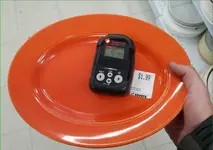UnderMiner
Silver Member
- Joined
- Jul 27, 2014
- Messages
- 3,953
- Reaction score
- 10,379
- Golden Thread
- 2
- Location
- New York City
- 🥇 Banner finds
- 2
- Detector(s) used
- Minelab Excalibur II, Equinox 800
- Primary Interest:
- All Treasure Hunting
Stopped by the thrift store today and saw this beautiful platter. The color was very distinct bright orange and I was fairly certain this was the infamous Uranium-based glaze I had researched last year. So I ran to my truck and got my radiation detector. Sure enough the detector screamed 'Radioactive, get the hell away from this thing!' Measured in at 42 Millirem! (Normal background radiation is only 1 or 2 Millirem) I bought it for $1.99 and it was my only purchase for the day.

Uranium-based glazed ceramic was popular prior to the US intervention in WWII (from about 1930-1943). It was made using Uranium Oxide which was a bright orange in color. In 1943 the US government banned the use of Uranium by non-government civilians and seized all the industrial Uranium from private manufactures for use in the Manhattan project (which was top secret at the time). The same Uranium used to make these dinner plates was then included in the batch that produced the world's first Uranium-based atomic bombs, Trinity and Little Boy, that latter of which was used to destroy the city of Hiroshima.
The U.S. Environmental Protection Agency states that 'radioactive glazed ceramics should not be used for food or drink use due to the possibility of leaching of Uranium or other heavy metals into food, especially acidic foods.' So happy I got this plate out of this store before it was purchased by a person who may have not know about it's harmful properties.

Uranium-based glazed ceramic was popular prior to the US intervention in WWII (from about 1930-1943). It was made using Uranium Oxide which was a bright orange in color. In 1943 the US government banned the use of Uranium by non-government civilians and seized all the industrial Uranium from private manufactures for use in the Manhattan project (which was top secret at the time). The same Uranium used to make these dinner plates was then included in the batch that produced the world's first Uranium-based atomic bombs, Trinity and Little Boy, that latter of which was used to destroy the city of Hiroshima.
The U.S. Environmental Protection Agency states that 'radioactive glazed ceramics should not be used for food or drink use due to the possibility of leaching of Uranium or other heavy metals into food, especially acidic foods.' So happy I got this plate out of this store before it was purchased by a person who may have not know about it's harmful properties.
Upvote
25





